By Gretchen Leighliter, Laboratory Manager (Lodi, OH), and Bob Trinklein, Color Technology Manager (Pawtucket, RI), Teknor Color Company
The twin forces of computerization and global competition are continually raising the standard for quality in manufacturing, and some of the most stringent demands focus on color. Yet, while color is subject to the objective analysis required for modern quality assurance, it is essentially a human perception – a subjective phenomenon. The complications are further multiplied in the case of plastics, whose diversity greatly expands the scope of color variation.
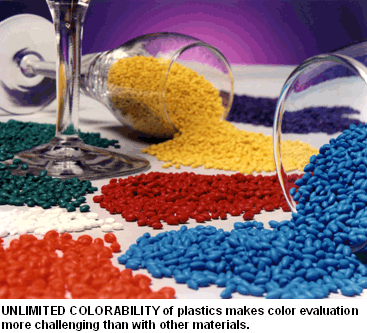 How can a manufacturer of plastic products or components ensure the closest possible match between the items coming off the production line and the color requirement set by the customer? First, by working closely with the color concentrate supplier to arrive at a color match based on an extensive review of the ingredients, processing, and anticipated use of the product. Second, by acquiring the capability for making informed decisions about the match samples developed by the concentrate supplier, and about the color consistency of products based on the approved match.
How can a manufacturer of plastic products or components ensure the closest possible match between the items coming off the production line and the color requirement set by the customer? First, by working closely with the color concentrate supplier to arrive at a color match based on an extensive review of the ingredients, processing, and anticipated use of the product. Second, by acquiring the capability for making informed decisions about the match samples developed by the concentrate supplier, and about the color consistency of products based on the approved match.
This article focuses on the second point – improving the reliability of color decisions. The most advanced techniques for color evaluation are based on instruments and software that quantify color standards and measure differences with precision and repeatability. Yet quantitative analysis can never eliminate need for human judgment based on accumulated experience with color in plastics.
The Eye: Basic Tool for Color Evaluation
The tool most widely used to evaluate color is still the human eye. While sophisticated machines like spectrophotometers are used to determine color acceptability and repeatability, the final judgment in most industrial color work is still based on visual analysis. And there is good reason for this.
In the first place, while spectrophotometers can be costly, the eye is free. Even so, the eye is a wonderful instrument. To a remarkable degree, the eye-brain combination can be used to compensate for gloss and surface differences. And the eye is an excellent null detector, which is to say that it is capable of discerning very slight differences in color. The eye of a person with average to above-average color vision can differentiate between approximately 10 million shades of color!
Of course the eye has limitations. Just as humans vary in physical characteristics, their color vision varies as well. It can range from very good to very poor or even color-blind. Color-blindness affects approximately 8% of men and 0.5% of women. Tests exist that can be used to evaluate both color-blindness and visual color acuity. Because many people who have color vision issues are unaware that they have these afflictions, and people generally tend to overestimate their own abilities, it is very important to administer these tests to those who will be making color decisions.
Optical fatigue is another factor affecting color perception, particularly when viewing very bright colors. After viewing a color for more than about 20 seconds, most people experience this phenomenon, caused by a tiring of the color-sensing cells of the eye. The remedy is to view colors no longer than about 10 seconds. If a go/no-go decision has not been made, set the color down for a minute or so, and look around the room. Do not review the color until this short rest period is over.
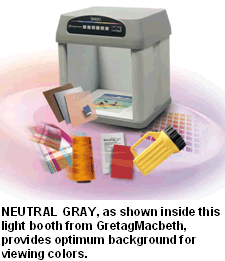 Another factor that can cause problems with color evaluations is the background used to view the color. Colored backgrounds can dramatically change the perception of a color. The best background for making color decisions is a neutral gray (such as Munsell N7). The best place to find such a background is in a light booth created to enhance color vision capabilities.
Another factor that can cause problems with color evaluations is the background used to view the color. Colored backgrounds can dramatically change the perception of a color. The best background for making color decisions is a neutral gray (such as Munsell N7). The best place to find such a background is in a light booth created to enhance color vision capabilities.
Instruments for Measuring Color
For all its remarkable sensitivity to color, the human eye cannot define it quantitatively for precise and repeatable analysis of color differences. Fortunately, manufacturers now can choose among a range of instruments that scientifically measure, quantify, describe, and compare color in plastic parts, ruling out environmental conditions, fatigue, and other factors affecting color perception. While all of these instruments employ photosensitive detectors to measure sample reflectance, they vary widely in sophistication, accuracy, and repeatability.
The earliest and simplest of instruments to find wide use is the tristimulus colorimeter. Its design is based on the three necessary elements of color analysis: a stable light source, a sample to analyze, and an observer, in this case a simple photoelectric cell detector. The source illumination is filtered to remove all but three specific wavelengths of light, corresponding roughly to the three natural color detectors present in the human eye: red, green, and blue. The filtered light beam is directed on the sample and the detector cell measures the intensity of reflected light.
Though colorimeters are still in use, their limited capability for exact measurement of complex colors has relegated them to quantifying the whiteness and yellowness indices of natural polymers and the brightness values of white pigments. Now more widely used is the more modern diffuse sphere spectrophotometer, integrated with a microcomputer. In this instrument, the light source illuminates the sample indirectly, eliminating many of the spectral interferences that biased earlier forms of measurement. Replacing the simple photoelectric cell is a sophisticated monochromator. Instead of measuring only three wavelengths, the monochromator analyzes the light reflected by the sample at discrete wavelengths across the entire range of the visible spectrum, typically taking measurements at increments from 400 to 700 nm. The extensive data yielded by this instrument makes it the tool of choice for adding scientific validity to color formulation and evaluation.
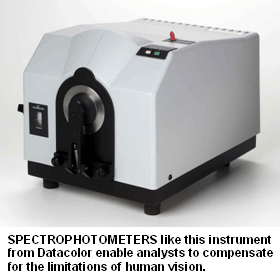 Scientific Analysis of Color
Scientific Analysis of Color
Spectrophotometers work in conjunction with computers to carry out a method of analysis called color tolerancing. The key to this technique is the system of mathematical equations incorporated in the software program.
While available instruments employ a number of different equations for color tolerancing, the most widely used is CIELab (based on a model developed by the Commission Internationale de l’Éclairage, or CIE). In terms of a three-axis coordinate system, the CIELab color space defines the lightness/darkness, red/green, and yellow/blue characteristics of a sample. Tolerances established in CIELab color space can be visualized as a cube around the sample position. The area within the cube is geometrically equal in all areas of color space. Thus this method of tolerancing assumes that humans perceive visual differences in areas of hue, chroma, and lightness/darkness equally.
There are some places in color space, however, where CIELab color tolerances do not correlate closely with visual color perception. As a result, tolerances can be established that allow approval of a bad visual match or rejection of a good visual match. In fact, it is known that humans can tolerate differences in lightness/darkness much more readily than differences in the shade (hue) or brightness (chromaticity) of a color.
To provide better correlation between visual perception and instrumental evaluation of color, industry technical experts have developed new tolerancing schemes such as CMC. Testing has determined that the shape that best approximates human perception of acceptable color tolerances is an ellipsoid. For that reason, tolerances established in CMC and other similar color spaces can be visualized as an ellipsoid around the position of the standard in color space. The ellipsoid represents the volume of acceptance and varies in size depending on the hue, lightness, and chroma of the standard.
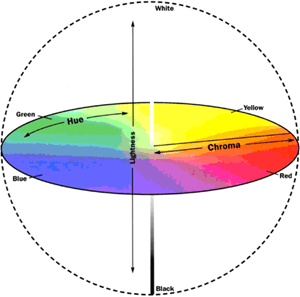
There are other color equations – such as CIE94 and the newly released CIE2000 – that use ellipsoidal color tolerancing and correlate well with visual color assessment. While no system performs perfectly in all situations, those that use ellipsoidal tolerancing better represent what we really see.
Color Analysis: The Limitations of Instruments
While it is impossible to perform scientific color analysis without instrumentation, even rigorous science has its limitations. The most reliable approach to color matching is based on the powerful combination of a knowledgeable, properly trained human being and a sophisticatedinstrument like the spectrophotometer. This is because four major factors affect the viability of instrumental data alone:
1. Metamerism is a phenomenon whereby two samples appear to match visually under one light source (natural daylight, for example) but not another (incandescent or fluorescent lighting). The ideal is for the samples to be non-metameric, but in practice this is sometimes impossible. Though spectrophotometric data may indicate the occurrence of metamerism, determining the acceptability of color requires a subjective judgment. It is best to determine at the outset that metamerism exists by using visual methods in combination with a calibrated light booth.
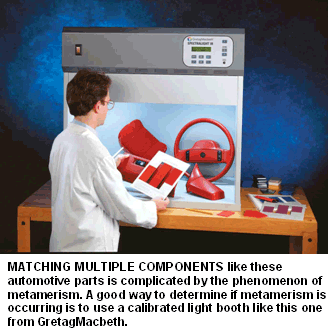
2. Fluorescence is the property in certain samples of absorbing energy in the UV range of the spectrum and converting it to visible light. This visible light is detected by instrumentation, adding error to the data retrieved. A few spectropho-tometers can determine the presence or absence of fluorescence by making two tables of data, one with the aid of a special UV filter, and then comparing them. Any disagreement indicates the presence of fluorescence. In the absence of such sophistication, the fluorescence can be determined by placing the sample in a darkened room and illuminating it with black (UV) light.
3. Directionality of color occurs with special pigments like metallics and pearlescents and can cause the spectrophotometer to provide different readings based on the orientation of the part being measured. Spectral data generated for samples such as these may be unusable for accurate color comparisons. A specialized spectrophotometer called a goniospectrophotometer can be used to make more accurate color readings in these circumstances.
4. Specular gloss, while not technically an aspect of color itself, can generate error in the analysis produced by a spectrophotometer. As the gloss of any sample approaches 100% (i.e. that of a perfect reflector) a spectrophotometric detector becomes increasingly saturated, interfering with data integration. Resulting data often indicate that samples are lighter than they actually are, even as visual evaluation indicates the reverse.
Because diffuse-sphere instruments mitigate this surface effect only to a limited degree, instrument manufacturers may include the capability of making color readings in either “specular-included” or “specular-excluded” mode. Some instruments even allow averaging of the two modes, the microcomputer mathematically calculating a “gloss compensation” into the reported data. Nevertheless, visual examination is the quickest and most reliable way to determine the presence of any specular gloss error. If the sample under evaluation looks too dark to you, it probably is, whether or not the instrument agrees with what you see. Your customer will probably see it the same way you do.
In applying the techniques discussed in this article, the manufacturer of colored parts is not working in a vacuum. Professional colorists at concentrate suppliers like Teknor Color Company operate extensive laboratories dedicated to solving color-match problems. In addition, design engineers increasingly employ specialized software to develop raw-material specifications that take into account many of the factors affecting the ultimate color of a product. By working closely with these partners in product development, manufacturers can meet the most stringent standards of color quality set by their customers.
About the Authors
| Gretchen Leighliter, Laboratory Manager and Bob Trinklein, Color Technology Manager Teknor Color Company Website: http://www.teknorapex.com/index.html |
Gretchen Leighliter has 20 years of experience with plastics colorant technology. She manages the color laboratory at Teknor Color Company’s manufacturing facility in Lodi, OH and worked for Accurate Color at that location when it was acquired by Teknor Color in 1995. Previously she had worked at Ampacet Corp.’s R&D Center in Terre Haute, IN and at A. Schulman Co., Akron, OH.
Bob Trinklein has worked in the business of coloring plastics since 1979. He has served on the Board of Directors for several SPE sections including the Southern Section, and is past Chairman of the SPE Color and Appearance Division (CAD). Bob also served as the CAD Newsletter Editor for 5 years. He has regularly presented papers on color issues at both Antec and Retec, and was recently named an SPE Honored Service Member. He has chaired both an Antec session and a Retec for the CAD. |
The views, opinions and technical analyses presented here are those of the author or advertiser, and are not necessarily those of ULProspector.com or UL Solutions. The appearance of this content in the UL Prospector Knowledge Center does not constitute an endorsement by UL Solutions or its affiliates.
All content is subject to copyright and may not be reproduced without prior authorization from UL Solutions or the content author.
The content has been made available for informational and educational purposes only. While the editors of this site may verify the accuracy of its content from time to time, we assume no responsibility for errors made by the author, editorial staff or any other contributor.
UL Solutions does not make any representations or warranties with respect to the accuracy, applicability, fitness or completeness of the content. UL Solutions does not warrant the performance, effectiveness or applicability of sites listed or linked to in any content.


